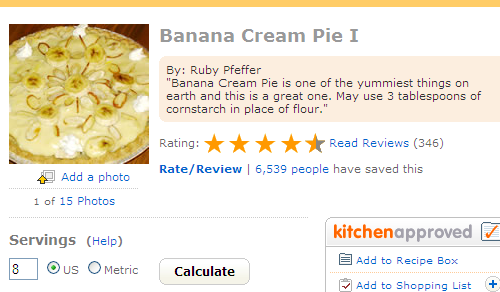A Microcosm of Technical Writing in the Kitchen While Cooking a Banana Cream Pie
As part of my contribution to the Thanksgiving dinner, Shannon tasked me to cook a banana cream pie. She had a simple recipe already printed out.
All the ingredients were available in the kitchen. The kitchen even had a double oven. I thought this would be easy, except it wasn't. Because I suck at cooking. I hate cooking. If I cook, I need a "man's cookbook," one that cuts through the jargon and explains cooking concepts in idiot-like detail.
For example, try to make sense of this step:
Stir a small quantity of the hot mixture into the beaten egg yolks, and immediately add egg yolk mixture to the rest of the hot mixture.
This does not make sense to me. Pour A into B, and B into A? No reason given for this. Just do it. Why not simply pour A into B or B into A, rather than doing a little of both at nearly the same time?
Jane explained that this back-and-forth pouring of the hot custard would bring the egg yolks up to a warmer temperature slowly without causing the eggs to curdle. Oh, I said. Now I see, but that connecting logic was simply assumed in the instructions.
Here's another place I tripped up:
In a saucepan, combine the sugar, flour, and salt. Add milk in gradually while stirring gently. Cook over medium heat, stirring constantly, until the mixture is bubbly. Keep stirring and cook for about 2 more minutes, and then remove from the burner.
Uhm, if I put dry ingredients in a saucepan on medium heat, they start to burn. Also, am I to mix the dry ingredients before adding them to the saucepan? How long do I have to stir this mixture -- 5 minutes, 10 minutes? Bubbly means ... slightly boiling, aerated, or some other state?
I stirred and stirred, but apparently not violently enough to get out all the clumps. I swear the mixture never got bubbly, but about 10 minutes into this step the mixture became thick and creamy -- something I wasn't expecting because there's nothing in the instructions that indicated a dramatic change of state. Again, was I just supposed to know that the state would change, and that the changed state would mean the mixture was done?
I guess I had questions throughout. Here's another place where I ran into a problem:
Slice bananas into the cooled baked pastry shell. Top with pudding mixture.
The recipe calls for 4 bananas. After I added 3, Shannon said to stop because there wouldn't be any more room in the pie. But perhaps the pie's final shape was meant to be convex, rounded at the top like a small hill? And if I put the bananas at the bottom and the pudding on top, wouldn't that be uneven? Wouldn't it be better to mix the two somehow for a more even distribution?
Finally, the banana cream pie recipe made no mention about whipped cream. Am I supposed to whip cream and add it to the top of the pie, like I'm accustomed to seeing in coconut-cream pie? Or is the custard filling the cream component of the pie?
I repeated several times my desire for a man's cookbook, one that would provide more details, more straightforward explanations, and more hand-holding.
Yet for Jane, she preferred the abbreviated, concise recipe style because she's familiar with the terminology and methods. When a recipe says to prick a pie shell, she knows about how many pricks to make, how deep to make them, and how much space between all the pricks. When I see instructions to prick a pie shell, I'm thinking up all kinds of scenarios about what this could mean.
Is not documentation exactly like this? You have the novices and the power users, and the instructions will inevitably frustrate one and appease the other.
Perhaps this is why I like online formats so much, because they allow you to add the extra detail in links pointing to additional pages, in drop-down hotspots, or through little information pop-ups. You're not restricted by space.
My pie turned out well in the end. I'm guessing there was some wiggle room and leniency in the instructions, which is perhaps why some seemed vague. Overall, the Thanksgiving cooking experience was a perfect microcosm for the world of technical writing.
About Tom Johnson

I'm an API technical writer based in the Seattle area. On this blog, I write about topics related to technical writing and communication — such as software documentation, API documentation, AI, information architecture, content strategy, writing processes, plain language, tech comm careers, and more. Check out my API documentation course if you're looking for more info about documenting APIs. Or see my posts on AI and AI course section for more on the latest in AI and tech comm.
If you're a technical writer and want to keep on top of the latest trends in the tech comm, be sure to subscribe to email updates below. You can also learn more about me or contact me. Finally, note that the opinions I express on my blog are my own points of view, not that of my employer.

